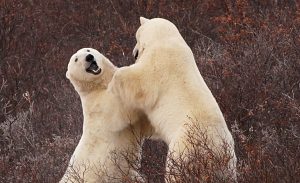Karupelv Valley Project in North-East Greenland

A quickly warming Arctic is the climate’s early warning system of our Earth. The dramatic impacts caused by climate change can be observed foremost in the Arctic. Monitoring and evaluating changes on a regular basis are therefore effective tools to understand the impacts on global ecosystems and to adapt adequate measures.
Carried out under the auspices of German and French scientists the Karupelv Valley Project has been helping to evaluate the effects of global warming on the ecosystem of the Arctic as well as the flora and fauna of Greenland for over 30 years now. Among experts this project is known as the most detailed and continuous work in this field worldwide. Results of the research are effectively contributing to protect affected habitats and threatened species. The investigation of the flyways of the long-tailed skua or long-tailed jaeger (Stercorarius longicaudus), for example, has led to the protection of their North Atlantic resting ground. Furthermore, data collected by the Karupelv Valley Project revealed that snowy owls are an endangered species, and for this reason, they are even listed on the Red List of Threatened Species.

Even experts are amazed by the research results. Scientists involved in the project are publishing their results locally and nationwide on a regular basis to inform the public about the impacts of the climate change in the Arctic. Thanks to a coverage of the Karupelv Project on tv the chairmen of People For Polarbears were able to get to know Johannes Lang, a biogolist and Arctic explorer from Hesse and scientist in charge of the Karupelv Project. This luckily led to a new long-time cooperation.
The Karupelv Valley Project is mainly devoted to polar bears – a key motif of the Arctic
Little is known of the polar bear population in North-East Greenland. There is no accurate and relevant data on its population, neither if their population is increasing or decreasing. This region could be the last refuge for polar bears in case if the Arctic continues to be affected by global climate change.
The effects and impacts of the climate change on the habitat and behavior of the polar bears have been studied for over 30 years now thanks to the Karupelv Valley Project. The provided data shows that polar bears come into conflict with humans and these conflicts may become more frequent as the bears spend more time on land due to climate warming induced sea ice loss.
Human-wildlife conflicts are flaring up which often end deadly for the polar bears. Scientists in charge of the Karupelv Project and the Foundation of PEOPLE FOR POLARBEARS have decided to sustainably work together in a long-term cooperation to reduce human-bear-conflicts. Our main goal is to promote a respectful handling and understanding of the polar bears to avoid such human-bear conflicts.

As such projects are rarely given financial support from an official side, we have decided to support this valuable project which has been collecting data for over 30 years now. We will mainly fund necessary equipment and safety devices for the protection of both humans and animals. On the one hand the scientists in charge urgently need safety measures to be able to continue their work on the ground. On the other hand, we need to invest in upgrading the equipment of the team of researchers. Our cooperation is mutually effective as on the one hand it is involved in the purchase of much needed devices, and on the other hand, we can help with our expertise. Moreover, all people in charge can get in touch easily and solve problems in their mother tongue, and above all, we are faithful to our mission to protect the polar bears’ natural habitat as well as to be transparent on all levels. This cooperation is a win-win situation for all.
We will continuously present all procedures and results on this page. Thus, anyone interested can witness the effectiveness of joining local and global forces. Our joint slogan reads, “Bundling Local Know-how for Global Environmental Protection” and which, from now on, represents the core of our common vision.


Bad Homburg v. d. Höhe im Mai 2017
Der Vorstand – Stiftung MENSCHEN für EISBÄREN
Volker Henrich Sören Zickermann

